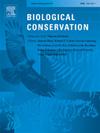Uncovering the conservation effectiveness of community forests: A case study from Shan State in Myanmar
IF 4.9
1区 环境科学与生态学
Q1 BIODIVERSITY CONSERVATION
引用次数: 0
Abstract
Community forestry is a regime of forest management that engages local communities to conserve forests and improve their livelihoods. As the number of community-conserved forests grows, a growing body of evidence indicates the positive effects of community forests in reducing deforestation. However, there is little analysis encompassing the comprehensive effectiveness of community forests (CFs) in terms of deforestation, forest degradation, forest cover change and forest increase. Here, we conducted a comprehensive analysis to investigate the influence of CFs on these aspects between 2015 and 2019 in two watershed conservation forests in Myanmar. We used visual interpretation of very high-resolution satellite imagery and applied propensity score matching to ensure a balanced distribution of covariates. When compared directly, deforestation inside CFs (5.08 %) were higher than those outside CFs (3.89 %), while forest degradation (23.73 %) and forest increase (11.86 %) inside CFs were lower than those outside CFs (24.9 % and 16.34 %, respectively). However, these differences were not significant, and the matching results showed that CFs did not exhibit significant control over deforestation, forest degradation, forest cover change, and improvements in forest cover compared to areas outside CFs. We conclude that establishing community forests alone does not guarantee forest conservation in the short term. Therefore, community-based forest management practices are needed to address deforestation and forest degradation and achieve effective forest conservation aligned with local needs.
揭示社区森林的保护成效:缅甸掸邦案例研究
社区林业是一种森林管理制度,让当地社区参与保护森林并改善其生计。随着社区保护林数量的增加,越来越多的证据表明社区森林在减少森林砍伐方面具有积极作用。然而,很少有分析涵盖社区森林在森林砍伐、森林退化、森林植被变化和森林增长方面的综合效果。在此,我们进行了一项综合分析,以调查 2015 年至 2019 年期间社区森林在缅甸两个流域保护森林中对这些方面的影响。我们对高分辨率卫星图像进行了直观解读,并采用倾向得分匹配法确保协变量的均衡分布。直接比较发现,流域保护林内的森林砍伐率(5.08%)高于流域保护林外的森林砍伐率(3.89%),而流域保护林内的森林退化率(23.73%)和森林增加率(11.86%)低于流域保护林外的森林退化率(24.9%)和森林增加率(16.34%)。然而,这些差异并不显著,比对结果表明,与社区森林外的地区相比,社区森林对森林砍伐、森林退化、森林植被变化和森林植被改善的控制并不明显。我们的结论是,仅仅建立社区森林并不能在短期内保证森林保护。因此,需要以社区为基础的森林管理实践来解决森林砍伐和森林退化问题,并根据当地需求实现有效的森林保护。
本文章由计算机程序翻译,如有差异,请以英文原文为准。
求助全文
约1分钟内获得全文
求助全文
来源期刊

Biological Conservation
环境科学-环境科学
CiteScore
10.20
自引率
3.40%
发文量
295
审稿时长
61 days
期刊介绍:
Biological Conservation is an international leading journal in the discipline of conservation biology. The journal publishes articles spanning a diverse range of fields that contribute to the biological, sociological, and economic dimensions of conservation and natural resource management. The primary aim of Biological Conservation is the publication of high-quality papers that advance the science and practice of conservation, or which demonstrate the application of conservation principles for natural resource management and policy. Therefore it will be of interest to a broad international readership.
 求助内容:
求助内容: 应助结果提醒方式:
应助结果提醒方式:


